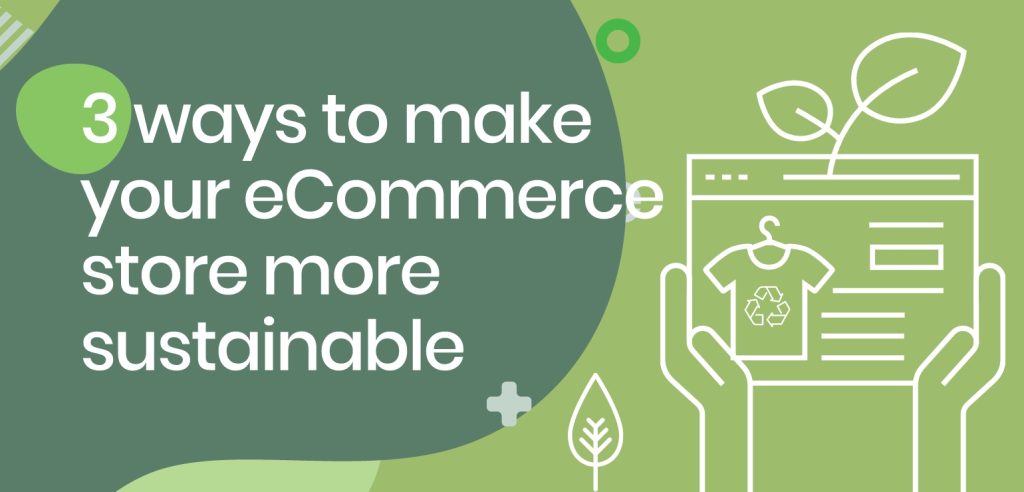3 ways to make your eCommerce store more sustainable

Article topics
- Offset your carbon dioxide use
- Review your packaging
- Review your returns and shipping model
3 ways to make your eCommerce store more sustainable
We’re all doing what we can to become greener in our day-to-day lives. We’re recycling our packaging, saying no to single-use plastic, and fixing things rather than throwing them away.
However, did you know there are things you can do to make your eCommerce store more eco-friendly too?
It’s been long-established that online shopping is more sustainable than buying from brick-and-mortar stores, with 35% less energy consumption and carbon dioxide emissions. Nevertheless, there are still things you can do to make your eCommerce store a more environmentally friendly option.
Here are three ways you can make your eCommerce business a greener place to shop.
Offset your carbon dioxide use
A quick win when it comes to sustainability is to offset your carbon dioxide use.
This is when you measure how much carbon dioxide your company emits, and fund an equivalent carbon dioxide saving somewhere else. While it’s still important to reduce your business’s carbon footprint for the planet’s sake, this is a good starting point.
You can offset your carbon dioxide use by planting trees in forests, investing in renewable energy, participating in community projects, and getting involved in waste-to-energy schemes. This is when waste projects are taken and converted into electricity.
Review your packaging
Amazon came under fire a few years ago for using too much packaging in its orders. In a 2019 poll, over half of Gen Z shoppers thought the online marketplace used excessive amounts of packaging.
Over the years, Amazon has started to make changes to reduce the amount of packaging it uses, including no longer utilising single-use plastic bags.
If you want to become more sustainable, it pays to look at how you package your products ready for delivery. Here are some things to consider:
- Choose the right-sized packaging. Not only is this more environmentally friendly, but it can help reduce damage and returns as the product won’t be rattling around
- Use recycled and recyclable materials where possible. Shoe brand Toms has pledged to use 100% recyclable packaging by 2025
- Consider biodegradable packaging like paper and cardboard over single-use plastics
- Tell your customers how they can repurpose their packaging. For example, Samsung provides customers with instructions to turn cardboard packaging into magazine holders and cat houses!
It also pays to think outside the box. One eCommerce business that is doing great things with its packaging is Lush. The beauty brand originally used popcorn to pack its online orders rather than Styrofoam, eventually moving to a biodegradable cornstarch-based packaging developed in-house.

Review your returns and shipping model
With eCommerce shipping increasing by a staggering 48% in the space of two years, online stores need to do what they can to reduce carbon emissions.
Here are some of the ways you can offer more sustainable shipping, as well as reduce returns.
Offer eco-friendly shipping options
Free shipping is a deal-breaker for many customers, with two-thirds of them expecting it on every purchase they make. However, compromise is needed in the modern day and age.
If you have to ship items at different times, encourage customers to hold off until you can send everything in one go. Amazon offers customers money off on their next order for agreeing to wait for delivery.
Alternatively, work with a courier with a dedicated approach towards carbon neutrality. Some couriers use EV and biofuel fleets, enhanced infrastructure, and green distribution centres to reduce their carbon footprint.
Implement paid returns
Several eCommerce stores now charge customers for returns, including Boohoo, Next, Uniqlo, and Zara.
While this has been implemented to offset rising shipping costs in most cases, businesses can also use it to encourage customers to think about what they’re buying.
Over-ordering means additional transport and shipping to send items back to the supplier. Not only this, but one out of every four returns can’t be resold, meaning products end up in landfill.
Are customers happy with the idea of paid returns? Not really. Seven out of ten shoppers said they’d stop shopping with a business that phased out free returns. However, given the state of the planet and the cost of living, more and more eCommerce stores are likely to start charging customers for returning items.
As an alternative, you can consider a modified returns model. Charge customers for their returns to be collected by a courier, but make returns to store free of charge.
Provide better product descriptions
The three main reasons why customers return online products are because they didn’t fit, they weren’t as described, and they look different in real life. One in five UK shoppers admits to buying clothes in more than one size, returning the ones that don’t fit.
Providing better product information can help shoppers make more informed decisions, reducing returns and boosting sustainability.
Focus on detailed product copy, integrate customer reviews into pages, and upload high-quality photos and videos.

It’s easy being green when it comes to your eCommerce store
Making your eCommerce store more sustainable isn’t just good for the environment; it’s good for your bottom line too!
57% of UK shoppers say they will pay more for environmentally friendly products, with Gen Z and Millennials even likelier to pay more for sustainable shopping.
We hope this article has given you valuable insight into what you can do to make your eCommerce business the eco-friendly choice.
Don’t forget to check out our blog for more of the latest news and insights when it comes to web development and digital marketing.


 Back
Back
